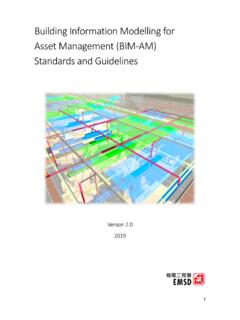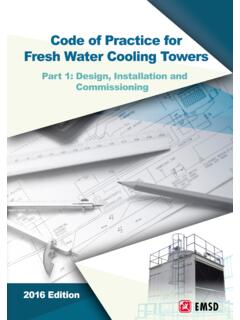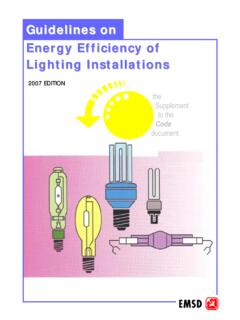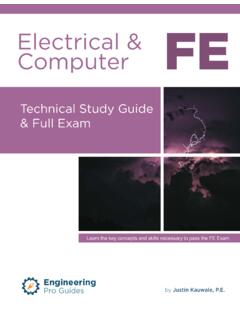Transcription of Technical Guidelines on Charging Facilities for Electric ...
1 Technical Guidelines on Charging Facilities for Electric Vehicles Page 1 of 16 Issued in April 2015 Introduction 1. This set of Technical Guidelines sets out the statutory requirements and general Guidelines for installation of Charging Facilities for Electric vehicles (EV) in Hong Kong. 2. This set of Technical Guidelines supersedes all previous Technical Guidelines on Charging Facilities for Electric vehicles and shall apply to new Charging Facilities . Existing Charging Facilities conforming to previous Technical Guidelines may continue to be used unless such Facilities are being altered, added or improved in which case this set of Technical Guidelines shall apply.
2 3. The terms and definitions used in this set of Technical Guidelines are listed in Annex A Statutory Requirements 4. Electric vehicle Charging Facilities are fixed electrical installations and shall comply with the relevant requirements of the Electricity Ordinance (Cap. 406) and its subsidiary Regulations. 5. electrical work on EV Charging Facilities including design, installation, commissioning, inspection, testing, maintenance, modification and repairing shall be carried out by registered electrical contractors and registered electrical workers of the appropriate grade.
3 International and National Standards 6. The International Electrotechnical Commission (IEC), Society of Automotive Engineers (SAE) of United States, and GuoBiao (GB) of China are the three most common conductive Charging standards for EVs. In addition, CHAdeMO is a DC quick Charging standard which was developed in Japan. IEC standard is adopted by most European EV Technical Guidelines on Charging Facilities for Electric Vehicles Page 2 of 16 Issued in April 2015 manufacturers while SAE by United States of America and Japan.
4 GB is the national standard adopted by mainland EV manufacturers. Standard IEC IEC 61851 SAE SAE J1772 GB GB/T 20234 CHAdeMO CHAdeMO
5 7. These standards define Charging methods, communication signals as well as plug and socket designs. SAE and IEC standards share the same communication protocol between EV and charger, but have different designs for plug and socket interface. GB operates on a different communication protocol and hence is not compatible with SAE or IEC. 8. Where applicable, this set of Technical Guidelines makes reference to the IEC standard. Modes of Charging 9. The four different modes of Electric vehicle conductive Charging specified in IEC 61851 are illustrated in Annex B.
6 Mode 1 10. For Mode 1 Charging , an AC Charging current is delivered via a standard socket outlet BS1363 13A and a Charging cable without communication function to the on-board charger of the EV. The presence of a residual current device (RCD) is a must on the supply side of the fixed electrical installation. This mode of Charging is suitable for longer period of Charging at home or in office. Technical Guidelines on Charging Facilities for Electric Vehicles Page 3 of 16 Issued in April 2015 Mode 2 11.
7 For Mode 2 Charging , an in-cable control box is incorporated into the Charging cable assembly. The provision of fixed electrical installation for Charging facility is similar to that for Mode 1 except that the final circuit, protective device and socket outlet shall be of a suitable rating to cater for the higher level of Charging current not exceeding 32A. Mode 3 12. For mode 3 Charging , a dedicated EV supply equipment (EVSE) and a Charging cable assembly shall be employed. The control pilot cable of the Charging cable assembly allows communication between the EVSE and the on-board charger of an EV to perform functions including verification of connection with the EV, continuous checking of protective earth conductor integrity, energization and de-energization of the supply, and selection of Charging rate.
8 13. Dedicated Charging plug, socket and coupler are required for Mode 3 Charging , which are specially designed for EV Charging . 14. Subject to the power rating of the on-board charger of an Electric vehicle, Mode 3 Charging can deliver a higher Charging current ( 220V/32A, 380V/32A, 380V/63A) and hence a shorter Charging time. 15. Selection of EVSE shall depend on the Charging protocol of the EV and on advice of the EV manufacturer. Mode 4 16. Mode 4 Charging employs the principle of using an off-board charger to deliver a DC current directly to the battery bypassing the on-board charger.
9 DC quick Charging can charge up an EV in a relatively short time as a substantially higher electrical power ranging from 20kW to 120kW is used. Technical Guidelines on Charging Facilities for Electric Vehicles Page 4 of 16 Issued in April 2015 Quick Charger CHAdeMO 17. DC quick chargers typically of 50kW capacity in compliance with the Japanese CHAdeMO protocol (Mode 4 off-board Charging ) are currently available in Hong Kong. Combined Charging system (CCS) 18. The CCS integrates one-phase AC Charging , three-phase AC Charging and DC Charging into a single vehicle inlet.
10 This universal Charging system will allow EV owners to recharge at most existing Charging stations regardless of power source. 19. There are two variants of the CCS. One is based on SAEJ1772 socket interface (equivalent to IEC Type 1 socket) and the other based on IEC Type 2 socket interface. They are called Combo 1 and Combo 2 respectively. The former is more commonly used in EVs from the while the latter is more so among EVs from European countries. Multi-standard system 20. In recent market development, EV charger manufacturers have launched multi-standard products to enhance the versatility of EV chargers.













